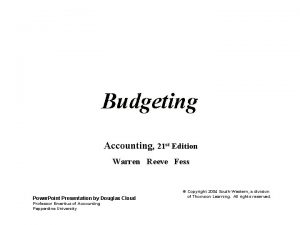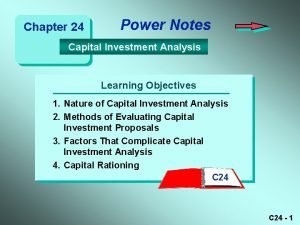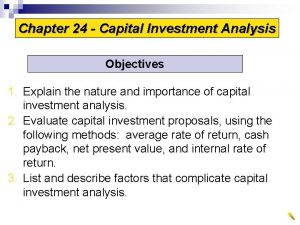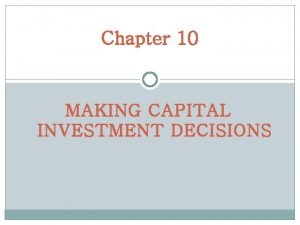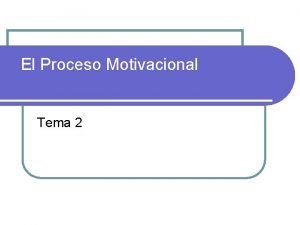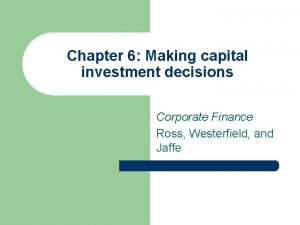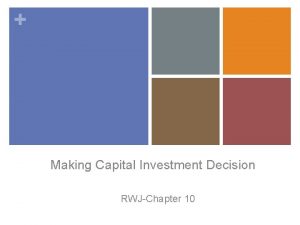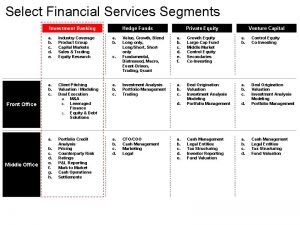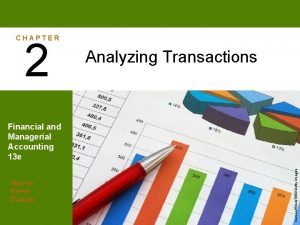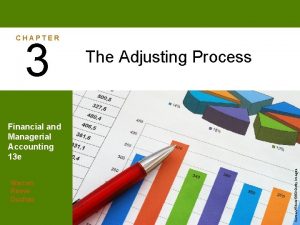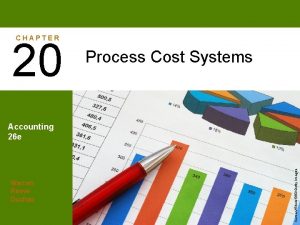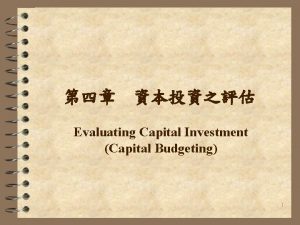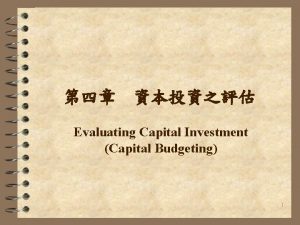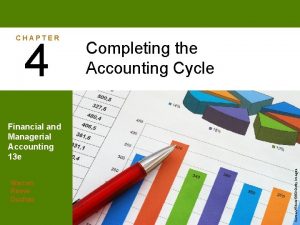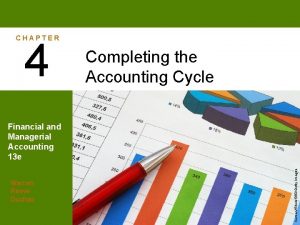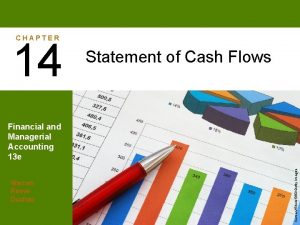CHAPTER 10 Capital Investment Analysis Warren Reeve Duchac



























- Slides: 27

CHAPTER 10 Capital Investment Analysis Warren Reeve Duchac human/i. Stock/360/Getty Images Managerial Accounting 13 e

Nature of Capital Investment Analysis • • Capital investment analysis (or capital budgeting) is the process by which management plans, evaluates, and controls investments in fixed assets. Capital investment evaluation methods include: o Methods That Do Not Use Present Values § Average rate of return method and Cash payback method o Methods That Use Present Values § Net present value method and Internal rate of return method • Present value considers the time value of money concept which recognizes that a dollar today is worth more than a dollar tomorrow because today’s dollar can earn interest. © 2016 Cengage Learning. All Rights Reserved. May not be scanned, copied or duplicated, or posted to a publicly accessible website, in whole or in part.

Average Rate of Return Method (slide 1 of 2) • • The average rate of return, sometimes called the accounting rate of return, measures the average income as a percent of the average investment. The average rate of Estimated return is computed as Average Annual Average Rate of Return = follows: Income Average Investment o Assuming straight-line depreciation, the average Initial Cost + Residual Averageis. Investment investment computed =as follows: Value 2 © 2016 Cengage Learning. All Rights Reserved. May not be scanned, copied or duplicated, or posted to a publicly accessible website, in whole or in part.

Average Rate of Return Method (slide 2 of 2) • The average rate of return has the following three advantages: o o o • It is easy to compute. It includes the entire amount of income earned over the life of the proposal. It emphasizes accounting income, which is often used by investors and creditors in evaluating management performance. The average rate of return has the following two disadvantages: o o It does not directly consider the expected cash flows from the proposal. It does not directly consider the timing of the expected cash flows. © 2016 Cengage Learning. All Rights Reserved. May not be scanned, copied or duplicated, or posted to a publicly accessible website, in whole or in part.

Cash Payback Method (slide 1 of 2) • • • The expected period of time between the date of an investment and the recovery in cash of the amount invested is the cash payback period. When annual net cash inflows are equal, the cash payback period is computed as follows: Initial Cost Cash Payback Period = Annual Net Cash Inflow When the annual net cash inflows are not equal, the cash payback period is determined by adding the annual net cash inflows until the cumulative total equals the initial cost of the proposed investment. © 2016 Cengage Learning. All Rights Reserved. May not be scanned, copied or duplicated, or posted to a publicly accessible website, in whole or in part.

Cash Payback Method (slide 2 of 2) • • A short cash payback period is desirable. The cash payback method has the following two advantages: o o • It is simple to use and understand. It analyzes cash flows. The cash payback method has the following two disadvantages: o o It ignores cash flows occurring after the payback period. It does not use present value concepts in valuing cash flows occurring in different periods. © 2016 Cengage Learning. All Rights Reserved. May not be scanned, copied or duplicated, or posted to a publicly accessible website, in whole or in part.

Methods Using Present Values • • • An investment in fixed assets may be viewed as purchasing a series of net cash flows over a period of time. The timing of when the net cash flows will be received is important in determining the value of a proposed investment. Present value methods use the amount and timing of the net cash flows in evaluating an investment. © 2016 Cengage Learning. All Rights Reserved. May not be scanned, copied or duplicated, or posted to a publicly accessible website, in whole or in part.

Present Value Concepts • Both the net present value and the internal rate of return methods use the following two present value concepts: o o • Present value of an amount Present value of an annuity The process of interest earning interest is called compounding. © 2016 Cengage Learning. All Rights Reserved. May not be scanned, copied or duplicated, or posted to a publicly accessible website, in whole or in part.

Compound Amount of $1 for Three Periods at 12% © 2016 Cengage Learning. All Rights Reserved. May not be scanned, copied or duplicated, or posted to a publicly accessible website, in whole or in part.

Partial Present Value of $1 Table © 2016 Cengage Learning. All Rights Reserved. May not be scanned, copied or duplicated, or posted to a publicly accessible website, in whole or in part.

Present Value of an Amount of $1. 404 © 2016 Cengage Learning. All Rights Reserved. May not be scanned, copied or duplicated, or posted to a publicly accessible website, in whole or in part.

Present Value of an Annuity • An annuity is a series of equal net cash flows at fixed time intervals. o • Cash payments for monthly rent, salaries, and bond interest are all examples of annuities. The present value of an annuity is the amount of cash needed today to yield a series of equal net cash flows at fixed time intervals in the future. © 2016 Cengage Learning. All Rights Reserved. May not be scanned, copied or duplicated, or posted to a publicly accessible website, in whole or in part.

Present Value of a $100 Amount for Five Consecutive Periods © 2016 Cengage Learning. All Rights Reserved. May not be scanned, copied or duplicated, or posted to a publicly accessible website, in whole or in part.

Partial Present Value of an Annuity Table © 2016 Cengage Learning. All Rights Reserved. May not be scanned, copied or duplicated, or posted to a publicly accessible website, in whole or in part.

Net Present Value Method (slide 1 of 2) • The net present value method compares the amount to be invested with the present value of the net cash inflows. o • • It is sometimes called the discounted cash flow method. The interest rate (return) used in net present value analysis is the company’s minimum desired rate of return. It is sometimes termed the hurdle rate. If the present value of the cash inflows equals or exceeds the amount to be invested, the proposal is desirable. © 2016 Cengage Learning. All Rights Reserved. May not be scanned, copied or duplicated, or posted to a publicly accessible website, in whole or in part.

Net Present Value Method (slide 2 of 2) • The net present value method has the following three advantages: o o o • It considers the cash flows of the investment. It considers the time value of money. It can rank projects with equal lives, using the present value index. The net present value method has the following two disadvantages: o o It has more complex computations than methods that don’t use present value. It assumes the cash flows can be reinvested at the minimum desired rate of return, which may not be valid. © 2016 Cengage Learning. All Rights Reserved. May not be scanned, copied or duplicated, or posted to a publicly accessible website, in whole or in part.

Present Value Index • • When capital investment funds are limited and the proposals involve different investments, a ranking of the proposals can be prepared using a present value index. The present value index is computed as follows: Total Present Value of Net Cash Present Value Index = o o Flow Amount to Be Invested A project will have a present value index greater than 1 when the net present value is positive. When the net present value is negative, the present value index will be less than 1. © 2016 Cengage Learning. All Rights Reserved. May not be scanned, copied or duplicated, or posted to a publicly accessible website, in whole or in part.

Internal Rate of Return Method (slide 1 of 3) • The internal rate of return (IRR) method uses present value concepts to compute the rate of return from a capital investment proposal based on its expected net cash flows. o This method, sometimes called the time-adjusted rate of return method, starts with the proposal’s net cash flows and works backward to estimate the proposal’s expected rate of return. © 2016 Cengage Learning. All Rights Reserved. May not be scanned, copied or duplicated, or posted to a publicly accessible website, in whole or in part.

Internal Rate of Return Method (slide 2 of 3) • When equal annual net cash flows are expected from a proposal, the internal rate of return can be determined as follows: o Step 1. Determine a present value factor for an annuity of $1 as follows: o Step 2. Locate the present value factor determined in Step 1 in the present value of an annuity of $1 table (see slide XX) as follows: § Locate the number of years of expected useful life of the investment in the Year column. § Proceed horizontally across the table until you find the present value factor computed in Step 1. o Identify the internal rate of return by the heading of the column in which the present value factor in Step 2 is located. © 2016 Cengage Learning. All Rights Reserved. May not be scanned, copied or duplicated, or posted to a publicly accessible website, in whole or in part.

Internal Rate of Return Method (slide 3 of 3) • The internal rate of return method has the following three advantages: o o o • It considers the cash flows of the investment. It considers the time value of money. It ranks proposals based upon the cash flows over their complete useful life, even if the project lives are not the same. The internal rate of return method has the following two disadvantages: o o It has complex computations, requiring a computer if the periodic cash flows are not equal. It assumes the cash received from a proposal can be reinvested at the internal rate of return, which may not be valid. © 2016 Cengage Learning. All Rights Reserved. May not be scanned, copied or duplicated, or posted to a publicly accessible website, in whole or in part.

Factors That Complicate Capital Investment Analysis • Additional factors such as the following may impact capital investment decisions: o o o Income tax Proposals with unequal lives Leasing versus purchasing Uncertainty Changes in price levels Qualitative factors © 2016 Cengage Learning. All Rights Reserved. May not be scanned, copied or duplicated, or posted to a publicly accessible website, in whole or in part.

Income Tax • The impact of income tax on capital investment decisions can be material. o o For example, in determining depreciation for federal income tax purposes, useful lives that are much shorter than actual useful lives are often used. Also, depreciation for tax purposes often differs from depreciation for financial statement purposes. As a result, the timing of the cash flows for income taxes can have a significant impact on capital investment analysis. © 2016 Cengage Learning. All Rights Reserved. May not be scanned, copied or duplicated, or posted to a publicly accessible website, in whole or in part.

Lease versus Capital Investment • Some advantages of leasing a fixed asset include the following: o o o • The company has use of the fixed asset without spending large amounts of cash to purchase the asset. The company eliminates the risk of owning an obsolete asset. The company may deduct the annual lease payments for income tax purposes. A disadvantage of leasing a fixed asset includes the following: o It is normally more costly than purchasing the asset. § This is because the lessor (owner of the asset) includes in the rental price not only the costs of owning the asset, but also a profit. © 2016 Cengage Learning. All Rights Reserved. May not be scanned, copied or duplicated, or posted to a publicly accessible website, in whole or in part.

Uncertainty • All capital investment analyses rely on factors that are uncertain. o For example, estimates of revenues, expenses, and cash flows are uncertain. © 2016 Cengage Learning. All Rights Reserved. May not be scanned, copied or duplicated, or posted to a publicly accessible website, in whole or in part.

Changes in Price Levels • Price levels normally change as the economy improves or deteriorates. o General price levels often increase in a rapidly growing economy, which is called inflation. § During such periods, the rate of return on an investment should exceed the rising price level. If this is not the case, the cash returned on the investment will be less than expected. • Price levels may also change foreign investments. o This occurs as currency exchange rates change. § Currency exchange rates are the rates at which currency in another country can be exchanged for U. S. dollars. – If the amount of local dollars that can be exchanged for one U. S. dollar increases, then the local currency is said to be © 2016 Cengage Learning. All Rights Reserved. May not be scanned, copied or duplicated, or posted to a publicly accessible website, in whole or in part.

Qualitative Considerations • • Some benefits of capital investments are qualitative in nature and cannot be estimated in dollar terms. Some examples of qualitative considerations that may influence capital investment analysis include the investment proposal’s impact on the following: o o o Product quality Manufacturing flexibility Employee morale Manufacturing productivity Market (strategic) opportunities © 2016 Cengage Learning. All Rights Reserved. May not be scanned, copied or duplicated, or posted to a publicly accessible website, in whole or in part.

Capital Rationing • Capital rationing is the process by which management allocates funds among competing capital investment proposals. o o o Alternative proposals are initially screened by establishing minimum standards, using the cash payback and the average rate of return methods. The proposals that survive this screening are further analyzed, using the net present value and internal rate of return methods. At the end of the capital rationing process, accepted proposals are ranked and compared with the funds available. © 2016 Cengage Learning. All Rights Reserved. May not be scanned, copied or duplicated, or posted to a publicly accessible website, in whole or in part.
 Matthew reeve alya reeve
Matthew reeve alya reeve Christopher reeve alya reeve
Christopher reeve alya reeve Warren reeve fess accounting edition 21
Warren reeve fess accounting edition 21 Factors that complicate capital investment analysis
Factors that complicate capital investment analysis Factors that complicate capital investment analysis
Factors that complicate capital investment analysis Capital investment analysis is the process
Capital investment analysis is the process Factors that complicate capital investment analysis
Factors that complicate capital investment analysis Cca tax shield formula
Cca tax shield formula Nwc change
Nwc change Fixed investment and inventory investment
Fixed investment and inventory investment English reeve highline
English reeve highline Larry reeve
Larry reeve Christopher reeve spinal cord injury level
Christopher reeve spinal cord injury level Proceso motivacional
Proceso motivacional Spinal cord injury protocol
Spinal cord injury protocol Canterbury tales satire
Canterbury tales satire Lepra
Lepra Dr elizabeth reeve
Dr elizabeth reeve Working capital investment example
Working capital investment example How to calculate incremental cash flows
How to calculate incremental cash flows Scottish capital investment manual
Scottish capital investment manual Capital investment decision
Capital investment decision Making capital investment decisions
Making capital investment decisions Middle market investment banks
Middle market investment banks Making capital investment decisions
Making capital investment decisions Making capital investment decisions
Making capital investment decisions Warren pryor poem metaphor
Warren pryor poem metaphor My hometown poem analysis
My hometown poem analysis


